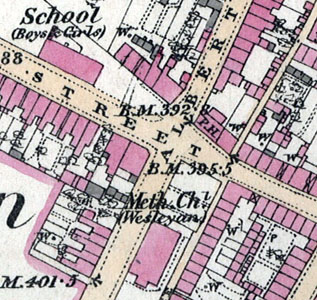Albert Road Wesleyan Methodist Church Luton

Albert Road chapel on a map of 1880
The congregation of Albert Road Wesleyan Methodist chapel begun meeting a temporary building in 1866. A notebook [MB412] tells us that a meeting on 11th October 1866 empowered a committee “to be the committee for Leasing or renting the Wooden Church”. The minutes go on: “A meeting of the Committee was then held when a letter from Mr. Welch was read offering the Building & Leases to the Wesleyans for the sum of £110.0.0.”
This church was the property of the Church of England. It had been erected for the use of the congregation of Saint Mary's whilst their church was being restored. With that restoration at an end they had no further use for it, hence the Wesleyans' hope that they could buy it.
A later minute reading: “A communication was made to the effect that the Church Committee declined at present the Transfer of the Lease but would let the Building for the term of one year for the sum of Twenty five Pounds. It was unanimously resolved that the offer of the Church for 12 months for £25.0.0 including the Houses be accepted”.
In August 1867 the Church Committee were again approached to see if they would sell the wooden church. In October it was reported that they were willing to sell. A public meeting was called on 3rd October 1867 and £124/15/- promised with which to buy the building.
This wooden church was only a temporary measure and a new chapel was built on the site in Albert Road in 1872. It was on the south-east side of the road just south of its junction with Newtown Road. The Bedfordshire Times of 30th July reported: “The memorial stones of a new Wesleyan Chapel were laid on Monday, the 22nd inst., in the Albert-road, Luton, by four ladies – Mrs. Mees, Mrs. George Hunt, Mrs. J. H. Blundell and Mrs. F. C. Scargill per Miss Hunt. The ladies contributed £10 each and in the course of the afternoon the receipts were £59. A tea meeting was held in the afternoon, and a public meeting in the evening in the large chapel, Chapel-street, Mr. Henry Blundell in the chair, when other donations were announced, bringing up the total received to £441 10s. The contract was taken by Mr. Saunders. Sittings will be provided for 500 people at an estimated cost of £650”. Frank Scargill was a prominent solicitor in the town who built and lived in what is now Wardown Museum. John Hight Blundell was a justice of the peace and farmer at Woodside Farm, Caddington.
Edwin Welch researched the history of registrations in Bedfordshire for Bedfordshire Historical Records Society Volume 75 Bedfordshire Chapels and Meeting Houses [published in 1996] and found the a registrations for the new Albert Road Wesleyan Methodist chapel on 12th September 1872 by Richard Eland of Church Street, Luton. The registration was cancelled on revision on 4th November 1931.
The chapel closed, after a short life of 26 years, 1898 having been replaced by the newly built Bailey Hill chapel in nearby Baker Street. The old chapel was eventually demolished but not before being used as a Sunday School for Bailey Hill until about 1918; the building is still shown on the 25 inches to the mile Ordnance Survey map of 1901 and marked as a Sunday School.
Bedfordshire and Luton Archives and Records Service has the following records relating to the chapel:
- MB412: notebook containing minutes of meetings about the new chapel, accounts and subscription lists: 1866-1882;
- MB413: subscription list: 1866;
- MB623: baptism register: 1888-1898.